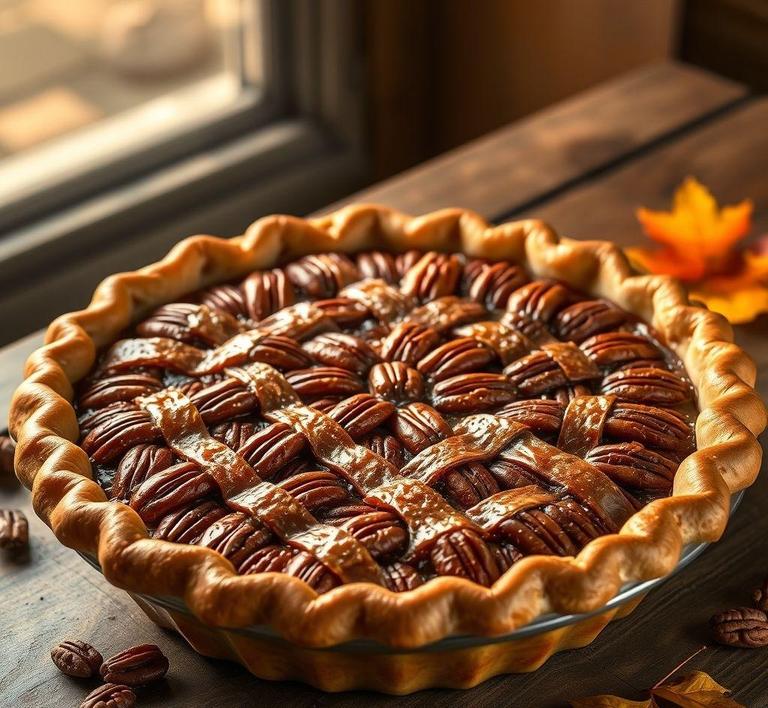Pecan pie is a beloved dessert, often a centerpiece at holiday gatherings and special occasions. But what happens if you make too much or have leftovers? Can you refreeze pecan pie? The good news is, yes, you can refreeze pecan pie! Whether you’ve baked it fresh or saved a store-bought one, freezing and refreezing this sweet treat can help maintain its flavor and texture for later enjoyment. In this guide, we’ll walk you through the best practices for refreezing pecan pie, so you can indulge in this delicious dessert whenever you like, without compromising on quality!
Can You Refreeze Pecan Pie?

Pecan pie, with its rich filling of caramelized brown sugar, butter, eggs, and those signature roasted nuts, is a beloved dessert, especially during the holidays. The question of whether you can refreeze pecan pie, however, often comes up when there are leftovers-or when someone makes too much for a single gathering. In short, yes, you can refreeze pecan pie, but it requires careful attention to detail to ensure the best possible result.
Pecan pie is made up of two primary components: a buttery, flaky pie crust and a filling that’s custardy in texture, thickened with eggs and sweetened with a syrupy concoction of brown sugar and corn syrup. These components, while delicious when fresh, can present certain challenges when freezing and refreezing, especially due to the high sugar content and the moisture levels within the pie filling.
The most significant concern when refreezing pecan pie is the effect it has on texture. The crispy crust, which is a hallmark of a perfect pecan pie, may become soggy or lose its crispness after being frozen and then refrozen. The filling itself, although more resilient, could also be affected, with the texture of the filling becoming a bit grainy or overly wet upon thawing, depending on how the pie was initially frozen and how many times it’s been exposed to freezing and thawing cycles.
The science behind this involves ice crystals forming in both the filling and the crust when the pie is frozen. During the initial freeze, small ice crystals form, which can cause moisture to separate in the filling and crust. The act of refreezing can lead to the formation of even larger ice crystals, further disrupting the structure of the pie. If the pie is not cooled properly, or if it’s thawed and refrozen without adequate care, the overall quality may be compromised.
How To Refreeze Pecan Pie?
If you’ve decided to go ahead and refreeze that leftover pecan pie, you’ll want to ensure that it’s done in a way that minimizes quality loss. Here’s how to do it:
1. Cool The Pie Completely
- Before freezing, always ensure that your pecan pie has cooled down to room temperature. This is crucial because placing a warm pie in the freezer can lead to condensation, which introduces excess moisture. This moisture will contribute to the breakdown of the crust and may result in a soggy pie once it’s thawed.
2. Wrap It Properly
- To keep the pie as fresh as possible during the freezing process, you’ll need to wrap it tightly. Start by wrapping the pie with a layer of plastic wrap or wax paper, ensuring it is tightly sealed and there are no gaps for air to get in. Follow that up with a layer of aluminum foil to provide extra protection from freezer burn and to help maintain the integrity of the crust. Alternatively, you could use an airtight freezer-safe container to store the pie, but it should be large enough to avoid squishing the pie.
3. Label And Date It
- Label the pie with the date you’re freezing it, so you can keep track of how long it’s been in the freezer. Pecan pie can be kept frozen for up to 3 months, but beyond that, both the texture and flavor could begin to deteriorate.
4. Freezing
- After wrapping, place the pie in the freezer in a stable position. Make sure the pie is not resting against anything that could deform it (like other frozen items). The goal is to keep the pie intact and in its original shape.
5. Thawing
- When you’re ready to enjoy your frozen pecan pie, it’s best to thaw it slowly. Transfer the pie from the freezer to the fridge and let it thaw for 6-8 hours or overnight. Thawing the pie slowly helps to maintain its texture and minimizes the risk of sogginess. If you’re in a hurry, you can also thaw it at room temperature for 2-3 hours, but be cautious as this method may result in moisture forming inside the pie, potentially softening the crust.
6. Rebake For Freshness
- To revitalize the pie after it’s thawed, pop it in the oven for 10-15 minutes at 350°F (175°C) to crisp up the crust and bring back some of that fresh-baked flavor. Just be sure to cover the crust with foil if it begins to brown too much while baking. This step is particularly helpful to restore the texture and flavor of the pie, especially if it was frozen for a longer period.
Quality Impact
While refreezing pecan pie is entirely possible, the quality of the dessert will inevitably be impacted in some ways. Freezing and refreezing any pie-especially one with a custard-based filling like pecan pie-can cause changes in texture and flavor that may not match the pie’s fresh, just-baked state. Below are the primary factors that influence the quality of refrozen pecan pie:
1. Texture Of The Crust
The most noticeable difference will likely be in the pie crust. Pecan pie’s crust starts out buttery and flaky, but freezing and refreezing tends to soften it. The process of freezing can make the crust lose its crispness, often resulting in a soggy or mushy bottom. The longer the pie is frozen, the more likely this is to happen. The refreezing process further disrupts the delicate balance between the crust and filling, making it difficult to restore the original crispness even with baking.
2. Filling Consistency
The filling is more resilient to freezing than the crust, but it’s not immune to texture changes. Ice crystals that form during freezing and refreezing can alter the consistency of the syrupy filling. Some people report that refrozen pecan pie filling becomes grainy or watery, particularly around the edges of the pie where the moisture is more prone to separation. The sugars may also crystallize slightly, making the filling feel less smooth.
3. Flavor Deterioration
Freezing and thawing also have the potential to impact flavor. While pecan pie doesn’t typically suffer a drastic loss of flavor after being frozen, subtle changes can occur over time. The caramelized sugar may lose some of its depth, and the buttery richness could be diminished. Freezing can also cause the nuts to lose their crispness, giving the filling a slightly soggy or chewy texture rather than the desirable crunch.
4. Moisture Separation
Perhaps one of the most significant quality changes after refreezing is the way moisture behaves in the pie. The filling may separate slightly, leading to pools of liquid in certain areas of the pie. This moisture separation can negatively affect the overall eating experience, especially when paired with a soggy crust.
So, can you refreeze pecan pie? Yes, but it’s a decision that comes with trade-offs. While it’s entirely possible to preserve your pecan pie for later consumption, the texture and flavor might not be as pristine as when the pie was fresh. If you choose to refreeze, it’s essential to do so with care: properly wrapping the pie, thawing it slowly, and rebaking it to revive the crust are all steps that can help mitigate some of the negative effects.
In the end, if you’re looking to maintain that delicate balance between a buttery, flaky crust and a rich, silky filling, it’s best to enjoy pecan pie fresh. But for those times when leftovers are inevitable, following the right freezing and thawing techniques will allow you to indulge in a satisfying slice, even if it’s not quite as perfect as when it was first made.
Is It Safe To Refreeze Pecan Pie?
Refreezing pecan pie can be done, but it’s not always the best idea if you want to preserve the flavor and texture of this decadent dessert. Pecan pie, with its rich, syrupy filling and flaky crust, can suffer a little when refrozen. However, if done properly, it’s possible to refreeze pecan pie and still enjoy a good slice after thawing.
The key to refreezing pecan pie safely hinges on how it’s handled both before freezing and after thawing. Refreezing pie that has been properly cooled and stored will minimize the risk of compromising the texture and quality. The freezing process essentially halts the activity of microorganisms, which helps preserve food, but repeated freezing and thawing can affect the moisture content and consistency, leading to sogginess or separation of the pie’s components.
One factor that might complicate refreezing is the high sugar content in pecan pie. Sugar can act as an agent that helps preserve the pie’s freshness, but the pie filling’s delicate nature can still change in texture, becoming more watery or runny upon thawing if not frozen correctly.
Signs That Pecan Pie Should Not Be Refrozen
Refreezing pecan pie isn’t a decision that should be taken lightly, and there are specific indicators that will help you determine whether your pie is past the point of safe refreezing. Here are some signs that suggest your pecan pie should not be refrozen:
- Mushy or Watery Filling: If the pie’s filling has already become runny, watery, or excessively soggy after the initial thaw, it will likely worsen with another round of freezing. The pie filling, particularly due to its high sugar content, can begin to separate from the crust and develop a mushy texture that’s unpleasant when reheated.
- Crust Disintegration: Pecan pie’s crust is particularly susceptible to the effects of freezing and thawing. If the crust has already become soft, soggy, or crumbled after thawing once, refreezing may cause it to lose its crispness even more. A mushy crust will affect the overall eating experience.
- Off Smell or Taste: If the pie develops any sour or unusual odors after being frozen and thawed, it could be a sign of spoilage. This could happen due to improper storage or extended time in the freezer, and the pie should not be refrozen under any circumstances.
- Frost or Ice Crystals Inside the Packaging: If the pie has developed large ice crystals on the surface or within the filling, it’s a sign that moisture is being released from the pie. Refreezing a pie that has already been exposed to moisture loss will result in a dry, unappetizing dessert upon reheating.
Common Refreezing Mistakes
When it comes to refreezing pecan pie, a few common mistakes can drastically affect its quality. Understanding these errors can help you avoid ruining your dessert and ensure that you get the best possible result when refreezing.
- Freezing Without Proper Cooling: One of the biggest mistakes you can make is freezing the pecan pie before it’s had a chance to cool completely. If you freeze a hot pie, moisture will form inside the packaging, and the filling will become soggy when thawed. Always allow the pie to cool to room temperature for at least two hours before freezing it.
- Not Wrapping the Pie Properly: Proper storage is essential for maintaining the quality of your pie. If you simply place the pie in the freezer without sealing it tightly, it can absorb unwanted odors and flavors from the freezer. Always wrap the pie in plastic wrap or aluminum foil, and consider placing it inside a freezer-safe container or a large zip-top bag for extra protection.
- Freezing Whole Without Cutting: While it’s perfectly fine to freeze a whole pecan pie, cutting it into slices before freezing can actually make it easier to thaw and serve later. Slicing it first allows for quicker, more even thawing, and ensures you don’t have to thaw the entire pie when you only want a piece or two.
- Refreezing Multiple Times: One of the worst things you can do is refreeze a pie multiple times. Each cycle of freezing and thawing damages the texture, causing the crust to become soggy and the filling to separate. If you’ve thawed and eaten part of your pie, it’s best to store the remaining pieces in the fridge and consume them within a few days rather than refreezing them.
- Storing Without Labeling: Forgetting to label your frozen pecan pie with the date it was frozen is another common mistake. Without labeling, it can be easy to lose track of how long it’s been in the freezer. Over time, frozen pies lose their flavor, and the filling may undergo undesirable changes. Label your pie with the date it was frozen and aim to consume it within 1-2 months for the best results.
Tips And Tricks
If you’re planning to freeze your pecan pie and refreeze it later, here are some helpful tips and tricks to ensure the best possible outcome:
- Flash Freezing: If you have the space in your freezer, consider flash freezing the pie before wrapping it. Place the pie on a baking sheet and freeze it for 1-2 hours, allowing it to firm up. This helps the pie maintain its shape and structure, reducing the risk of squashing it when you wrap it for long-term storage.
- Consider Freezing the Filling Separately: If you’re worried about the pie’s texture after freezing, consider freezing just the filling. You can bake the crust fresh later and then pour the thawed filling into it. This approach minimizes the chance of mushy crust and filling separation.
- Thawing Safely: To thaw pecan pie, place it in the fridge overnight or at room temperature for several hours. Thawing in the refrigerator will help retain the pie’s texture and prevent any bacterial growth. Avoid using a microwave to thaw, as this can cause the pie to become unevenly heated and ruin the texture of the filling.
- Reheat Carefully: If you want to serve a refrozen pie, reheat it gently in the oven. Preheat the oven to 350°F (175°C) and bake the pie for 15-20 minutes, or until the filling is hot and the crust is crispy. Cover the edges of the crust with foil if it begins to brown too quickly.
- Keep the Freezer at a Consistent Temperature: To maintain the quality of your frozen pecan pie, make sure your freezer is operating at a steady temperature of 0°F (-18°C). Fluctuations in temperature can cause the pie to thaw and refreeze, further damaging its texture.
Conclusion
While refreezing pecan pie is not the ideal method for preserving its taste and texture, it can be done successfully if handled with care. The most important factors to consider are how well the pie is initially frozen, the way it’s packaged, and how it’s thawed and reheated. Avoid common mistakes like not cooling the pie properly, storing it without wrapping, and refreezing multiple times. With the right techniques, you can enjoy your pecan pie even after freezing it-but for the best experience, consuming it fresh or within a reasonable time frame after thawing is always your safest bet.


